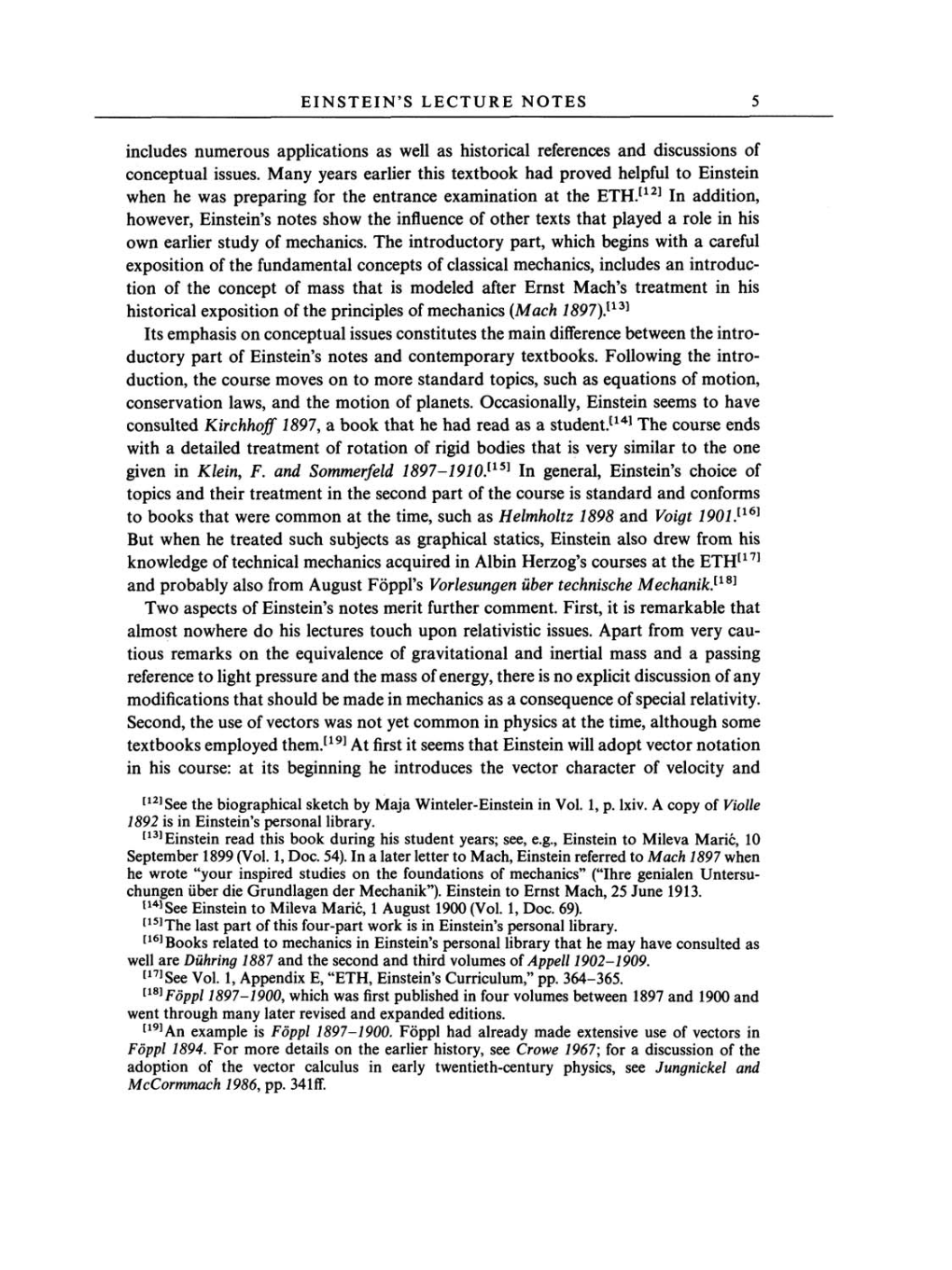EINSTEIN'S LECTURE
NOTES
5
includes
numerous
applications
as
well
as
historical references
and discussions of
conceptual issues. Many years
earlier
this textbook had
proved helpful
to
Einstein
when
he
was
preparing
for the
entrance
examination
at
the
ETH.[12]
In
addition,
however,
Einstein's
notes
show the
influence
of other
texts
that
played
a
role
in his
own
earlier
study
of mechanics. The
introductory part,
which
begins
with
a
careful
exposition
of the fundamental
concepts
of
classical
mechanics,
includes
an
introduc-
tion of the
concept
of
mass
that
is
modeled after Ernst Mach's
treatment
in his
historical
exposition
of
the
principles
of mechanics
(Mach
1897).[13]
Its
emphasis
on
conceptual
issues
constitutes the main
difference
between the intro-
ductory
part
of Einstein's
notes
and
contemporary
textbooks.
Following
the intro-
duction,
the
course moves on
to
more
standard
topics,
such
as
equations
of
motion,
conservation
laws,
and the motion of
planets. Occasionally,
Einstein
seems
to
have
consulted
Kirchhoff 1897,
a
book
that
he had read
as a
student.[14]
The
course
ends
with
a
detailed
treatment
of rotation of
rigid
bodies
that
is
very
similar
to
the
one
given
in
Klein,
F. and
Sommerfeld
1897-1910.[15]
In
general,
Einstein's choice of
topics
and their
treatment
in the second
part
of the
course
is
standard
and conforms
to
books
that
were common
at
the
time,
such
as
Helmholtz 1898 and
Voigt
1901.[16]
But when
he
treated such
subjects as graphical
statics,
Einstein also
drew from his
knowledge
of technical mechanics
acquired
in Albin
Herzog's
courses
at
the
ETH[17]
and
probably
also from
August
Föppl's Vorlesungen
über
technische
Mechanik.[18]
Two
aspects
of Einstein's
notes
merit further
comment. First, it is
remarkable
that
almost nowhere do his lectures touch
upon
relativistic
issues.
Apart
from
very cau-
tious
remarks
on
the
equivalence
of
gravitational
and inertial
mass
and
a
passing
reference to
light
pressure
and the
mass
of
energy,
there
is
no
explicit
discussion of
any
modifications
that
should be made in
mechanics
as a
consequence
of
special
relativity.
Second,
the
use
of
vectors
was
not
yet
common
in
physics
at
the
time, although
some
textbooks
employed
them.[19]
At
first
it
seems
that
Einstein
will
adopt
vector
notation
in his
course:
at
its
beginning
he
introduces the
vector
character of
velocity
and
[12]See
the
biographical
sketch
by
Maja
Winteler-Einstein
in Vol.
1, p.
lxiv.
A copy
of
Violle
1892 is in
Einstein's
personal library.
[13]Einstein read this book
during
his
student
years;
see, e.g.,
Einstein
to
Mileva
Maric,
10
September
1899
(Vol. 1,
Doc.
54).
In
a
later letter
to
Mach,
Einstein referred
to
Mach
1897 when
he wrote "your
inspired
studies
on
the foundations of mechanics"
("Ihre genialen
Untersu-
chungen
über die
Grundlagen
der
Mechanik").
Einstein
to
Ernst
Mach, 25
June
1913.
[14]See Einstein
to
Mileva
Maric,
1
August 1900
(Vol.
1,
Doc.
69).
[15]The last
part
of this
four-part
work is in Einstein's
personal library.
[16]Books
related
to
mechanics
in
Einstein's
personal library
that
he
may
have consulted
as
well
are
Dühring
1887
and the second and third volumes of
Appell
1902-1909.
[17]See
Vol.
1,
Appendix E,
"ETH,
Einstein's
Curriculum,"
pp.
364-365.
[18]Föppl
1897-1900,
which
was
first
published
in
four volumes
between 1897 and
1900
and
went
through many
later
revised
and
expanded
editions.
[19]An
example
is
Föppl
1897-1900.
Föppl
had
already
made extensive
use
of
vectors in
Föppl
1894.
For
more
details
on
the earlier
history,
see
Crowe
1967;
for
a
discussion of the
adoption
of the vector calculus
in
early twentieth-century
physics,
see
Jungnickel and
McCormmach
1986,
pp. 341ff.
